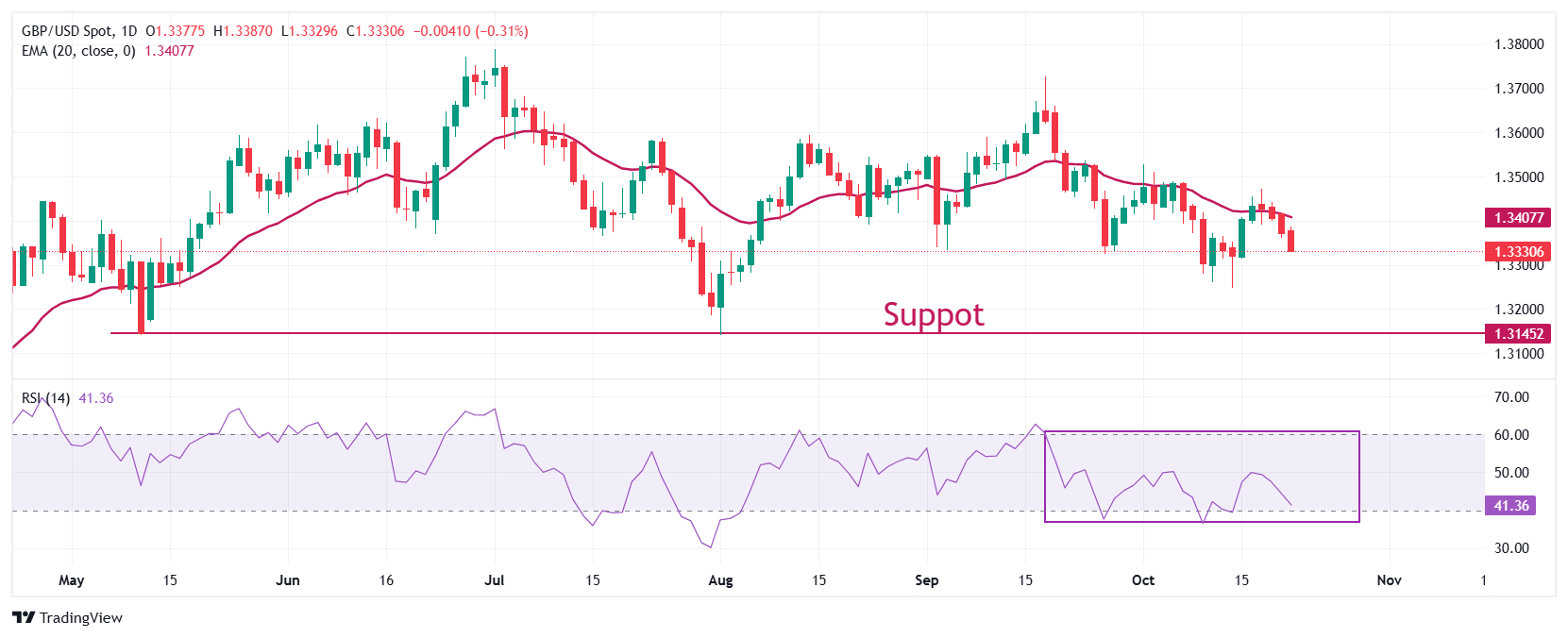Key Takeaways
- The British Pound weakened significantly following the release of the UK’s September Consumer Price Index (CPI) data.
- Both core and headline inflation figures fell below market expectations, indicating a potential easing of price pressures.
- This inflation data, combined with recent dovish signals from the Bank of England’s (BoE) employment report, has increased the likelihood of future interest rate cuts.
- The GBP/USD pair saw a continued decline, influenced by softer UK inflation and a strengthening US Dollar.
- Market attention is now turning to upcoming US CPI data, which could shape the Federal Reserve’s monetary policy outlook.
UK Inflation Slows, Impacting Pound Sterling
Pound Sterling (GBP) experienced considerable selling pressure against major currencies on Wednesday. This downturn occurred after the United Kingdom’s September Consumer Price Index (CPI) data was released, showing a slowdown in inflation.
💡 Official figures from the Office for National Statistics (ONS) indicated that core CPI, which excludes volatile items like food, energy, alcohol, and tobacco, rose by 3.5% annually. This reading was lower than the forecasted 3.7% and the previous month’s 3.6%.
📊 Headline inflation also showed a slower-than-anticipated annual increase of 3.8%, down from an estimated 4.0%. On a monthly basis, prices remained unchanged, contrasting with the 0.3% growth observed in August.
⚡ Inflation within the services sector, a key metric for the Bank of England (BoE), held steady at 4.7%.
Market Sentiment Shifts on Inflation and BoE Outlook
The observed easing of price pressures is bolstering market expectations for potential interest rate cuts by the BoE later in the year. These expectations were already supported by the previous week’s employment data for the three months ending August, which showed an uptick in the unemployment rate and a deceleration in wage growth.

GBP/USD Faces Pressure Amid Dollar Strength
The Pound Sterling continued its downward trend against the US Dollar, trading near the 1.3330 level during Wednesday’s European session. This marks the fourth consecutive day of losses for the GBP/USD pair.
📍 The depreciation of GBP/USD is also influenced by the broader strength of the US Dollar Index (DXY), which measures the Greenback’s performance against six major currencies. The DXY was trading firmly near recent highs around the 99.00 mark.
US Dollar Supported by Trade Deal Optimism and Government Reopening Hopes
Increased optimism regarding a potential trade agreement between the United States and China has provided a significant boost to the US Dollar. U.S. President Donald Trump has expressed confidence in achieving a fair deal.
⚡ Further support for the Dollar stems from growing hopes for the reopening of the US federal government this week, following productive discussions between Democratic leaders and President Trump.
Anticipated Economic Data Releases
Investors are now closely monitoring the delayed US CPI data for September, scheduled for release on Friday. This report is expected to considerably influence market sentiment concerning the Federal Reserve’s future monetary policy decisions.
📊 Economists project the US headline CPI to have risen by 3.1% on an annual basis, an acceleration from the previous 2.9% reading. Core CPI figures are also anticipated to show a steady increase to 3.1%.
Technical Analysis of Pound Sterling
From a technical standpoint, the Pound Sterling has struggled to maintain a recovery above the 20-day Exponential Moving Average (EMA), which is currently situated around 1.3407. This suggests a prevailing bearish momentum.
📍 The 14-day Relative Strength Index (RSI) has moved closer to the 40.00 level, indicating that a breach below this point could signal further downward pressure.
📌 Key support for the GBP/USD pair is identified at the August 1st low of 1.3140, while the psychological level of 1.3500 is expected to act as a significant resistance zone.
Understanding the Core Consumer Price Index (YoY) – United Kingdom
The United Kingdom’s Core Consumer Price Index (CPI), published monthly by the Office for National Statistics, tracks inflation by monitoring changes in the cost of goods and services purchased by households. The year-on-year (YoY) reading compares current prices to those of the same period in the previous year. Core CPI specifically excludes volatile components such as food, energy, alcohol, and tobacco, offering a clearer view of underlying inflation trends.
✅ This indicator is vital for assessing inflation dynamics and shifts in consumer spending patterns. An elevated reading is generally considered positive for the British Pound (GBP), whereas a lower reading tends to be viewed as bearish for the currency.
Learn more about this economic indicator.
Summary Insights
The September inflation figures from the UK suggest a potential cooling of price pressures, which has impacted the performance of the Pound Sterling. Market participants are closely observing forthcoming economic data for further clues on the Bank of England’s future monetary policy stance.

